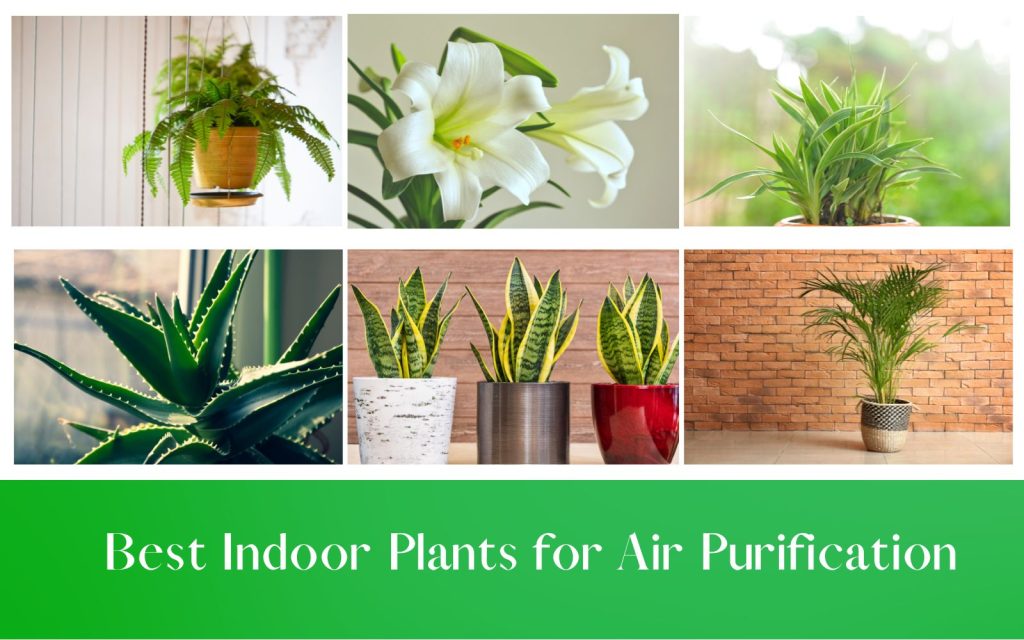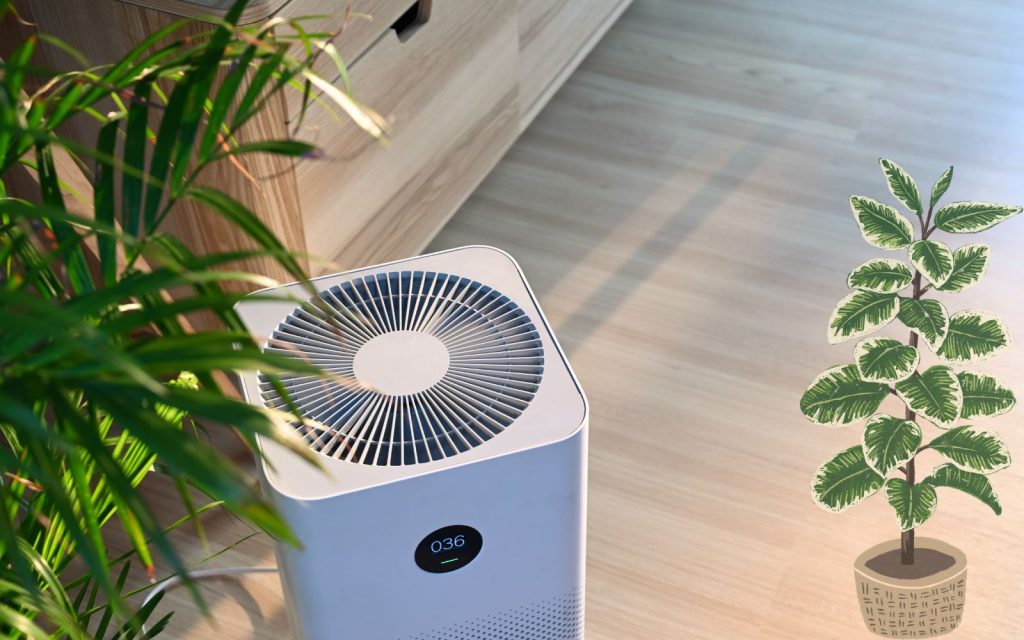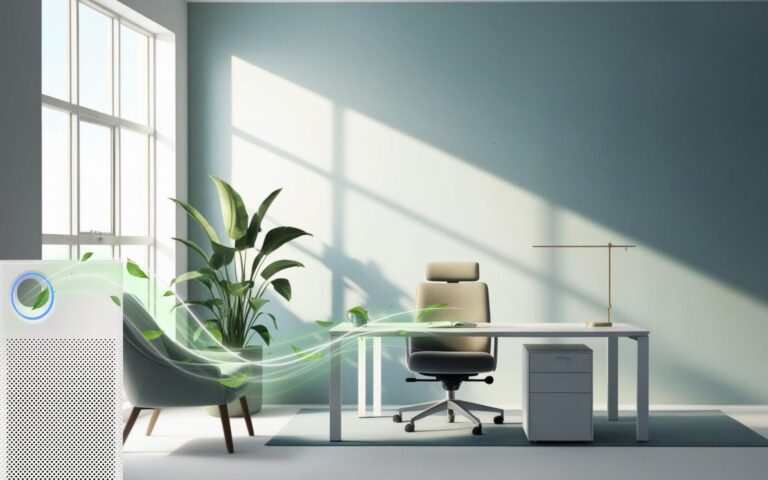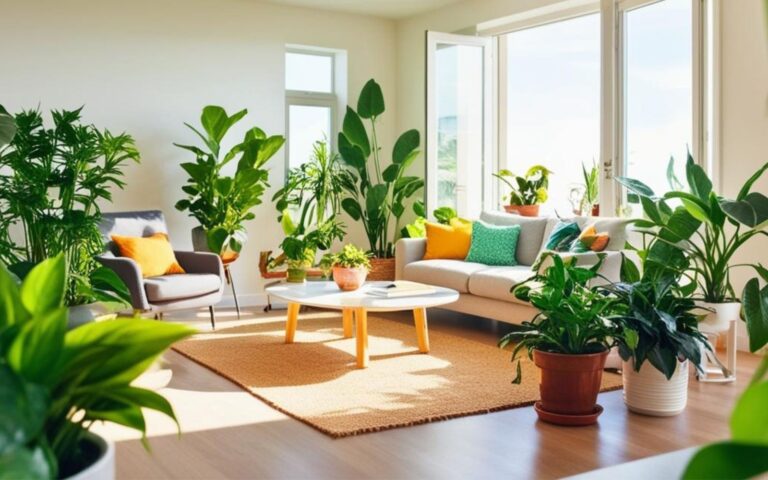How Indoor Plants Purify Air and Improve Indoor Air Quality: Nature’s Filtration

Did you know that indoor air can be more polluted than outdoor air? Actual indoor air pollutants such as volatile organic compounds (VOCs), dust, and mold can degrade the quality of your indoor environment.
Luckily, indoor plants are a natural solution to improve indoor air quality. These plants don’t just beautify your space; they also act as natural air purifiers, enhancing your indoor air purification efforts.
This article will explore how indoor plants purify air, the best plant species for the job, and how to create a healthier, fresher indoor environment.
Key Takeaways
- Indoor plants can significantly improve air quality by removing carbon dioxide and VOCs.
- They help balance indoor air humidity and enhance air purification by producing negative ions.
- Certain plant species are more efficient at air purification than others.
- Incorporating indoor plants can improve the indoor air environment and overall health.
How Indoor Plants Purify Air and Improve Indoor Air Quality?

Indoor plants are like nature’s own air filtration system. They absorb carbon dioxide, release oxygen, control humidity, and remove harmful pollutants. Here’s how:
1. Absorbing Indoor Air Pollutants
Indoor plants can absorb and break down harmful chemicals such as formaldehyde, benzene, and trichloroethylene, which are common indoor air pollutants.
These toxic pollutants are found in everyday household items such as paints, cleaning agents, and furniture.
The pollutants are absorbed through the leaves, roots, and soil, where they are metabolized by the plant or its surrounding microorganisms, contributing to indoor air remediation.
2. Releasing Oxygen and Removing Carbon Dioxide
Through photosynthesis, plants absorb carbon dioxide and release oxygen, significantly improving the indoor air quality.
This process refreshes the indoor air, particularly during the daytime when plants are most active. Plants can also help filter air by removing particulate matter, leading to cleaner indoor air.
3. Regulating Indoor Air Humidity
Indoor plants help regulate indoor humidity through transpiration, which releases moisture into the air. This increased humidity is beneficial, especially in dry indoor environments where heating or air conditioning systems lower humidity.
Improved humidity levels can enhance respiratory health, prevent dry skin, and even reduce the spread of certain airborne diseases.
Best Indoor Plants for Air Purification

Not all indoor plants are equally effective in air purification. Below are some of the best plant species for enhancing indoor air quality:
1. Spider Plant (Chlorophytum comosum)
The spider plant is known for filtering out harmful pollutants like formaldehyde and carbon monoxide. It’s also an excellent choice for homes with pets, as it’s non-toxic.
However, it can harm pets if consumed in large amounts, which is unlikely but something the homeowner should be cautious about. Spider plants are also highly effective in improving indoor air humidity.
2. Peace Lily (Spathiphyllum)
Peace lilies are excellent air purifiers, removing harmful VOCs such as benzene and trichloroethylene from the air. However, they can be toxic to pets, so be cautious about their placement.
They can be more suitable for office spaces where pets and homes without pets are more unlikely.
3. Snake Plant (Sansevieria trifasciata)
Snake plants are incredibly efficient at absorbing carbon dioxide and releasing oxygen, even at night, making them ideal for bedrooms. They are also robust and adaptable to various indoor environments.
However, snake plants contain saponins, which are toxic to cats. Hence, cat owners should be careful when considering the placement of this plant to reduce the chances of their cats consuming any part of the plant.
4. Boston Fern (Nephrolepis exaltata)
Boston ferns are particularly effective at increasing humidity, making them great for dry indoor spaces. They also remove pollutants such as formaldehyde and xylene from the air.
They are non-toxic to pets, but consumption in large amounts must be stopped to eliminate the chances of stomach issues.
5. Aloe Vera
Aloe vera is renowned for its healing properties and ability to absorb toxins such as formaldehyde and benzene, enhancing indoor air quality.
However, certain secretions from this plant can be toxic to cats, so pet owners should consider placing it carefully or skipping it altogether.
6. Areca Palm
Areca palms, or butterfly palms, are excellent pet-friendly choices for homes or office spaces. They require little space and bring a tropical feel to the room.
It absorbs allergens from the air, making it a top choice for indoor spaces. A room with bright natural light and a proper watering schedule is enough for this plant to thrive.
Enhancing Air Purification with Indoor Plants

To maximize the air purification benefits of indoor plants, consider the following tips:
1. Choose a Variety of Plant Species
Different indoor plant species absorb different toxins, so including various plants will target a broader range of indoor air pollutants. A mixture of air-purifying plants will also enhance the overall aesthetic of your indoor spaces.
2. Use the Right Number of Plants
Experts suggest having at least one air-purifying plant for every 100 square feet of living space. The more plants you add, the better the air filtration and overall improvement in indoor air quality.
3. Place Plants Strategically
For optimal air cleaning, place air-purifying plants near sources of pollutants, such as windows, kitchens, and high-traffic areas. This will ensure they absorb pollutants at the source and filter air more efficiently.
4. Keep Plants Healthy
Healthy plants perform better at air purification. Regularly clean their leaves, water them appropriately, and ensure they receive enough light to thrive.
Dust can clog plant leaves, reducing their ability to filter indoor air pollutants. Overwatering is also an issue, so research the required amount of water for each kind of plant before bringing it in. Organic insecticides should be used to get rid of insects in indoor plants.
The Impact of Indoor Plants on Health and Indoor Environments

Having indoor plants not only purifies air but also offers several other health benefits:
- Improved Mental Health: Studies have shown that exposure to indoor plants can reduce stress, anxiety, and depression. Plants create a calming indoor environment and contribute to better emotional well-being.
- Better Concentration and Productivity: Indoor plants enhance focus and creativity, making them an excellent addition to home offices or study spaces.
- Reduced Indoor Disease Transmission: Plants can help minimize the transmission of airborne illnesses such as influenza by improving indoor air quality and regulating humidity.
Addressing Myths About Plants and Air Purification

While indoor plants do significantly improve indoor air quality, some myths need to be dispelled:
- Myth 1: Plants Alone Will Eliminate All Indoor Toxins
Plants do an excellent job of absorbing toxins. Still, they should be used with other air purification methods, such as negative-pressure air flow systems and HEPA air purifiers.
- Myth 2: You Need Lots of Plants for Results
Even a few well-chosen plants can have a noticeable impact on air quality. You don’t need to plant every corner of your home to see benefits.
Summary
Indoor plants are nature’s air purifiers. They improve indoor air quality by absorbing pollutants, balancing humidity, and releasing oxygen. Spider plants, peace lilies, and snake plants are among the best choices for air purification.
By incorporating a variety of plant species and placing them strategically throughout your home, you can enhance your indoor air purification efforts and enjoy a cleaner, healthier living environment.
Frequently Asked Questions
How many plants do I need to purify the air in my home?
At least one medium-sized plant for every 100 square feet is recommended to improve indoor air quality.
Which plants are best for air purification?
Spider Plants, Peace Lilies, and Snake Plants are the most effective air-purifying plants.
Do plants improve air quality?
Yes, indoor plants absorb toxins, release oxygen, and help regulate indoor air humidity.
Are air-purifying plants safe for pets?
Yes, plants like spider plants and areca palms are safe for pets and excellent for air purification.
Can plants help with humidity?
Yes, plants increase indoor air humidity through transpiration, especially in dry environments.






One Comment